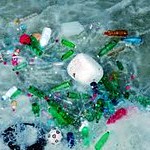
THE presence of ‘plastic soup’ in the oceans is regarded as a big problem. Tiny plastic particles enter the sea when plastic debris decompose and are also released from cosmetics and from clothes in the wash, subsequently entering the sewage system and surface waters and eventually reaching the sea.
Plastic nanoparticles in seawater can have an adverse effect on sea organisms. Particles measuring about a thirty millionth of a millimetre, and therefore invisible to the naked eye, are responsible. Mussels that have been exposed to such particles eat less, and thus grow less well, according to research carried out by scientists and students at Wageningen University and IMARES, both part of Wageningen UR. They wrote about their research in the most recent issue of Environmental Toxicology and Chemistry.
The EU and the Dutch government recognise the problem and the need to monitor the existence of plastics in the seas in order to learn more about present and future concentrations of plastic micro and nanoparticles in marine environments. Very little is known about the effects plastic nanoparticles have on sea life. The effects now discovered do not yet prove that plastic in the North Sea is a big problem, but they do suggest that further research is extremely important, the researchers remark.
This publication is the first of four by Wageningen University and IMARES into the effects of plastic in the North Sea. The other studies will be published in the near future. The first of these is research into the effect of plastic on lugworms, which lose weight due to uptake of plastic particles. The worms, as a result, take in more toxic substances such as polychlorinated biphenyls (PCBs), which bind to plastics.
The researchers believe this indicates the need for good research into other toxic substances that bind to plastic – an additional consequence of the presence of microplastics. In order to analyse the interaction of plastic and other toxic substances in the food web, the research group has made a detailed computer model. This type of model is crucial for estimating the risks plastics impose in the sea. The last piece of research is into plastic debris in the stomachs of fish. An analysis of hundreds of fish has shown that 12% of them have debris in their stomachs. Around half of that debris is plastic. (PRA)











